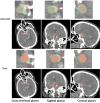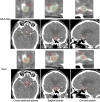CTA image segmentation method for intracranial aneurysms based on MGLIA net
- PMID: 40148442
- PMCID: PMC11950224
- DOI: 10.1038/s41598-025-95143-2
CTA image segmentation method for intracranial aneurysms based on MGLIA net
Abstract
Accurately segmenting the aneurysm area from CTA data can reconstruct the three-dimensional morphology of the aneurysm, effectively evaluating the type, size, and risk of rupture of the aneurysm. However, accurate separation of the aneurysm is limited by the accuracy of image segmentation algorithms. Currently, the segmentation methods for intracranial aneurysms using CTA big data and deep learning lack universality. When faced with a new hospital acquired imaging modality, it is usually necessary to redesign and train the segmentation network. In response to this issue, this article proposes a more universal segmentation model and develops the GLIA Net algorithm (MGLIA Net model) based on MoblieNet, which can perform adaptive target segmentation on aneurysm images collected under different conditions. To verify the effectiveness of the algorithm in intracranial aneurysm segmentation, performance tests were conducted on an open-source dataset. The results showed that the proposed algorithm achieved segmentation accuracy of 55.9% and 73.1% on two datasets, respectively, significantly better than the original GLIA-Net algorithm.
Keywords: CTA; Deep learning network model; Image segmentation; Intracranial aneurysm.
© 2025. The Author(s).
Conflict of interest statement
Declarations. Competing interests: The authors declare no competing interests.
Figures










References
-
- Hoh, B. L. et al. 2023 Guideline for the management of patients with aneurysmal subarachnoid hemorrhage: a guideline from the American heart association/american stroke Association[J]. Stroke54 (7), e314–e370 (2023). - PubMed
-
- Neifert, S. N. et al. Aneurysmal subarachnoid hemorrhage: the last decade[J]. Translational Stroke Res.12, 428–446 (2021). - PubMed
-
- Brisman, J. L., Song, J. K. & Newell, D. W. Cerebral aneurysms[J]. N. Engl. J. Med.355 (9), 928–939 (2006). - PubMed
MeSH terms
Grants and funding
LinkOut - more resources
Full Text Sources
Medical

